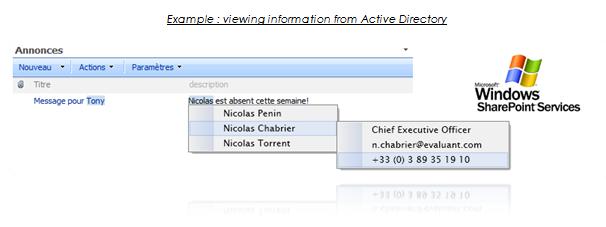Introduction
Rich interfaces offered with new Internet technologies are in emergence and seem to be promising. Associated directly to Internet, they allow enlarging view and interaction capacities. These elements can be transposed to the Intranet, but do they represent a real advantage?
The need of information capitalization is important. An Intranet site allows accessing this information.
Information accessibility in a firm is as important as its availability. Find a perfect way to attain the good information from IT infrastructure seem to be really hard but is necessary to optimize the firm organization through collaboration.
Navigation is a decisive characteristic because information is nothing if it is not visible. The difficulty of navigation on an Intranet and Internet result of an abandonment of the users who will hesitate to come back consult the site. This fact is amplified by the available of massive information.
To avoid this accessibility trouble, there is the possibility to set a search engine which allows finding faster pieces of data. However, using a search engine need to know what keyword we have to enter to get the definite information. For example, when you receive a mail from a colleague in which it have the message “Please contact Tony Thong if you have some questions about Intranet”, you will need more information and send back a mail to ask the mail or phone number to really get the contact. If you use a search engine, you may enter for keywords “Tony Thong email” or “Tony Thong contact” or “Tony Thong phone” and with some luck you will find the good page in Intranet to get employees information.
This type of situation can seem insignificant but represent a real loss of time when it is repeated on a large scale.
SemOA concept, a new user experience
Intranet need to be structured to allow ergonomic navigation and navigating through the massive information. In spite of a good structure, it is necessary to set some ways to accompany user when navigating.
The different accessibility ways we can often find on Internet is mainly:
Main navigation menu
Links
Pop-up
Contextual Menu
The main navigation menu is essential and is always or almost available. We cannot avoid links because this is the main navigation tool. Pop-up are often used to display advertising and are often considerate as “polluting”. Context menu are rarely used in Internet but always in Windows graphical interfaces. Profiting that the user will receive information they expect to, contextual menu are really useful for navigation.
Integrating automatically actions (redirecting, running phone call, video-conference, sending message) and information available in the whole of the IT infrastructure to SharePoint 2007 through a contextual graphical interface have a sense and represent the SemOA concept. The user does not need to look for the missing linked information because they are already served by an utility which weaves links between information available in the IT infrastructure and detect pertinent term in the page. Pieces of data go to user and not the reverse. This concept creates synergy between different applications which build the infrastructure.
Depending on the infrastructure, the click event on the mail can run Outlook or Outlook Web Access to send an email to the employee found. It is not limited to these actions.
Here Active Directory is the source but source can be taken from the whole of IT infrastructure. If you take Project Server for source, you will be able to retrieve information about membership of a project, some information linked to a project like expiry date, progress, etc.

.Net implementation
The implementation of this concept is favored by new Internet technologies. Its implementation for SharePoint 2007 is more favored by Silverlight 2.0 technology. SemOA’s goal is to provide a contextual access to different data sources which can be Active Directory, Exchange Server, Team Foundation Server, Communication Server, Project Server, SQL Server and others.
The context depends on elements found in intranet pages. To perform analyzing, it is necessary to catch pages with an “Httpmodule” before sending them to client. The pages will be marked to indicate keywords and insert a Silverlight 2.0 module for advanced graphical interface.
Using javascript interaction on the page is possible, but not without some constraints. Indeed, javascript means 3 troubles:
Silverlight 2.0 resolves these troubles and increase the capacity to evaluate. Indeed, you can change the module behavior by adding a plug-in system which can be view as “Silverlight assembly”.

The last versions of Microsoft solutions like Exchange 2007 or Project Server 2007 expose their own web services. It is possible to call web services from Silverlight 2.0 and it is used to communicate with different data sources.

Implementation of SemOA concept for SharePoint 2007 needs a good knowledge about the product. Indeed, SharePoint use some mechanisms with javascript to fill its lists (for example); that means that the javascript have to be analyze too and the task will be harder. Moreover, we have to take care about the editable area on SharePoint to avoid a recursive enrichment.
Conclusion
Rich Internet Applications offered new perspectives about user experience for Intranet. they can be integrated to SharePoint if you take care about the existing SharePoint mechanisms. They provide advantage only if they are applied to a definite objective like the SemOA concept and allow getting the best of your Intranet by increase ergonomics and software interaction.
